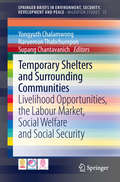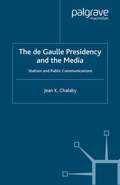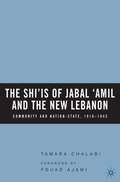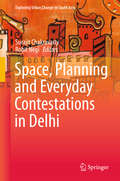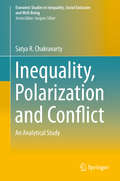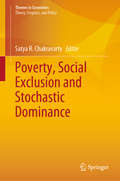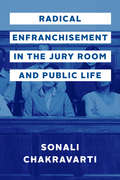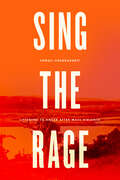- Table View
- List View
Popular Politics in the Making of the Modern Middle East (PDF)
by John ChalcraftThe waves of protest ignited by the self-immolation of Muhammad Bouazizi in Tunisia in late 2010 highlighted for an international audience the importance of contentious politics in the Middle East and North Africa. John Chalcraft's ground-breaking account of popular protest emphasizes the revolutionary modern history of the entire region. Challenging top-down views of Middle Eastern politics, he looks at how commoners, subjects and citizens have long mobilised in defiance of authorities. Chalcraft takes examples from a wide variety of protest movements from Morocco to Iran. He forges a new narrative of change over time, creating a truly comparative framework rooted in the dynamics of hegemonic contestation.
Temporary Shelters and Surrounding Communities: Livelihood Opportunities, the Labour Market, Social Welfare and Social Security (SpringerBriefs in Environment, Security, Development and Peace #15)
by Yongyuth Chalamwong Naruemon Thabchumpon Supang ChantavanichThis book is one of four volumes on a major empirical migration study by leading Thai migration specialists from Chulalongkorn University (Bangkok) for the United Nations Development Programme (UNDP).This volume reviews the livelihood opportunities for displaced persons in temporary shelters and in the surrounding communities. It explores labor-market conditions and provides recommendations for improving opportunities. The editors discuss the current policies of the Royal Thai Government towards displaced persons on restrictions for settlement that impede access to welfare, justice, education and health care. Service provision for displaced persons are identified here, as well as access to justice and other key services, including Thai services outside the settlements, and the potential for conflict with the local Thai population over resource allocation. Summarizing the results of a highly important research project this volume provides realistic policy recommendations for a durable solution for refugees at the borders. Policymakers from governments, international organizations and NGOs will benefit from its findings and conclusions.
The de Gaulle Presidency and the Media: Statism and Public Communications (French Politics, Society and Culture)
by J. ChalabyIs it true that de Gaulle kept journalists at a distance because he disliked the press? Or was the press really against him, as always claimed? How did he exploit his own charisma on radio and television? This book explores the relationship between de Gaulle and the media during his presidency. The author examines de Gaulle's communications strategy and broadcasting policy, comparing his approach to public communications with that of past French leaders and contemporary American presidents.
The Shi‘is of Jabal ‘Amil and the New Lebanon: Community and Nation-State, 1918–1943
by T. ChalabiTamara Chalabi highlights the development of a 'politics of demand' and the increased political activism of this community in a time of great change. It also explores how Arab nationalism was transformed from an ideology of opposition and empowerment of marginal communities, into a tool for the assertion of political domination.
Oil Policies, Oil Myths: Observations of an OPEC Insider
by Fadhil J. ChalabiThere was a lot of haranguing over this I think, as Dr Chalabi took umbrage at OPEC being referred to as 'notoriously opaque' - this old version is still on the database and therefore on the website, the jacket blurb should read:The world of oil and OPEC (the Organisation of Petroleum Exporting Companies) has often been misunderstood or seen as shrouded in mystique and myth. On the 50th anniversary of the foundation of OPEC, Fadhil Chalabi, a former 'insider' who spent many years at the heart of this organisation, dispels myths and invites us to discover the realities, environment and evolution of policies that have shaped OPEC and the oil industry. One of Carlos the Jackal's OPEC hostages in 1975, the author interweaves his analysis with first-hand experiences that give authenticity to momentous events, from the time of Egypt under Nasser, Gaddafi's Libya and Saddam's Iraq. Crucially, Chalabi's analysis encompasses Iraq's oil politics and their influence on OPEC and the impact of Iran on its pricing policies, which began with the Shah's dramatic campaign to maximise oil prices in 1973, followed by a period of volatile oil politics during Ayatollah Khomeini's Revolution of 1978-79 and its aftermath, leading to the Iraq-Iran war.Geopolitics have proved to be central to energy policies for both oil-rich and oil-needy countries. Today this garners even more attention, as the importance of the oil-rich countries of the Middle East, Africa and Latin America grows with the perennial demand for this resource. Oil Policies, Oil Myths explores the continuing importance of oil while examining the geopolitical influences that cause oil crises and price hikes and which undermine oil's future. Chalabi's expertise illuminates OPEC's role in this, while showing its successes and its failures. Oil for the countries of OPEC has been pivotal in their political and economic development, but it is also a crucial tool in their diplomatic relations with the oil-consuming nations of the East and West. Notwithstanding a critique of its oil-supply management, Chalabi sees OPEC's survival as essential. He re-appraises its fundamental role of securing the future availability of a vital global commodity and considers that the absence of OPEC would cause market mayhem, damage the world economy and our prospects for future energy supplies.This book is essential reading for those who wish to look beyond the myths of oil and of OPEC, scrutinise oil policies and an organisation that is perceived by the press as legendary for its opacity, and to understand OPEC's dramatic impact on the global energy industry, on world politics and economics.
The Other One Percent: Indians in America (Modern South Asia)
by Sanjoy Chakravorty Devesh Kapur Nirvikar SinghOne of the most remarkable stories of immigration in the last half century is that of Indians to the United States. People of Indian origin make up a little over one percent of the American population now, up from barely half a percent at the turn of the millennium. Not only has its recent growth been extraordinary, but this population from a developing nation with low human capital is now the most-educated and highest-income group in the world's most advanced nation. The Other One Percent is a careful, data-driven, and comprehensive account of the three core processes-selection, assimilation, and entrepreneurship-that have led to this rapid rise. This unique phenomenon is driven by-and, in turn, has influenced-wide-ranging changes, especially the on-going revolution in information technology and its impact on economic globalization, immigration policies in the U.S., higher education policies in India, and foreign policies of both nations. If the overall picture is one of economic success, the details reveal the critical issues faced by Indian immigrants stemming from the social, linguistic, and class structure in India, their professional and geographic distribution in the U.S., their pan-Indian and regional identities, their strong presence in both high-skill industries (like computers and medicine) and low-skill industries (like hospitality and retail trade), and the multi-generational challenges of a diverse group from the world's largest democracy fitting into its oldest.
Space, Planning and Everyday Contestations in Delhi (Exploring Urban Change in South Asia)
by Surajit Chakravarty Rohit NegiThis insightful volume examines the politics and contestations around urban space in India’s national capital, Delhi. Moving beyond spectacular megaprojects and sites of consumption, this book engages with ordinary space and everyday life. Sites and communities analysed in this volume reveal the processes, relations, and logics through which the city’s grand plans are executed. The contributors argue that urbanization is negotiated and muddled, particularly in the spaces occupied by informal labour, resettled communities, and small-scale investors. The critical analyses in this volume shed light on the disjunctures between planning and ideology, narratives of growth and realities of immobility, and facades of modernity and the spaces and practices produced in its pursuit. The book is organized in four parts – (I) Dis/locating Bodies, (II) Claims at the Urban Frontier, (III) Informalization and Investment, and (IV) Gendered Mobility. The studies report current empirical work from a variety of sites, investigating the dynamics of capital investment, state planning and citizen response in these spaces. These studies, set in ordinary spaces in Delhi, reveal a subliminal disarray of thought and action, stemming from the impetus to make the city attractive to capital, while having to manage marginality and reorganize welfare functions. The volume provides fresh insights into the nature of urban planning and governance in an Indian megacity two decades after the neoliberal shift.
Inequality, Polarization and Conflict: An Analytical Study (Economic Studies in Inequality, Social Exclusion and Well-Being #12)
by Satya R. ChakravartyThis monograph initially offers a systematic treatment of the theory and methodology of alternative notions of income polarization and related issues. It then goes on to analyze social polarization, ordinal polarization, and the relations between inequality polarization, fractionalization and likelihood of conflicts. Axiomatic approaches to the measurement of polarization from different perspectives are analyzed rigorously. In order to understand the difference between inequality and polarization, a discussion on income inequality is also included.
Poverty, Social Exclusion and Stochastic Dominance (Themes in Economics)
by Satya R. ChakravartyThis book honors the memory of Tony Atkinson, who made significant contributions to the rigorous study of income inequality, poverty, and redistribution. These essays presented, covering a span of over 30 years of research and scholarship, have been at the forefront of distributional analysis, and many of them are of prime importance for contemporary developments in the real-valued measurement of poverty and inequality, with particular reference to the concepts of fuzzy poverty assessment, vulnerability, heterogeneity/multidimensionality, unit consistency, sub-group decomposability, and dominance criteria. While all of these articles have been previously published—singly or with co-authorship—in a number of professional journals or distinguished edited volumes, this book is greatly enriched by a substantial introductions by the authors, which place the contributions in context, highlights their inter-connectedness, and relates them to the work of Tony Atkinson and other scholars. This book is of intrinsic value to welfare analysts, as well as being a tribute to a very great scholar by a fellow economist.
Novelist Tagore: Gender and Modernity in Selected Texts
by Radha ChakravartyRabindranath Tagore is widely regarded as a poet-philosopher and educationist, but his novels remain a relatively underexplored aspect of his oeuvre. Focusing on gender and modernity as key features of his fiction, this book charts Tagore's evolution as a novelist from self-conscious psychologizing in Chokher Bali to an engagement with nationalism in Gora and Ghare Baire (The Home and the World); a portrayal of asceticism and desire in Chaturanga (Quartet); an analysis of marriage, sexuality and change in Bengali society in Yogayog (Relationships); an effervescent fusion of social satire and literary experimentation in Shesher Kabita (Farewell Song); and an intense, dramatic study of love, politics and terrorism in Char Adhyay (Four Chapters). This study demonstrates that Tagore’s writings cannot be readily assimilated within current theoretical frameworks, and urges us to rethink the conventional oppositions between tradition and modernity, masculinity and femininity, East and West, and local and global. Addressing a major gap in the field, the book reconstructs Tagore as a novelist of eminent stature, demonstrates the range and complexity of his creative genius, his contribution to literary history and the relevance of his reflections to our times. Enriched by insights into the biographical and socio-historical contexts of his novels, this book will be of special interest to researchers, teachers and students of comparative and world literature, history, postcolonial studies and gender studies, as also to Tagore enthusiasts.
Novelist Tagore: Gender and Modernity in Selected Texts
by Radha ChakravartyRabindranath Tagore is widely regarded as a poet-philosopher and educationist, but his novels remain a relatively underexplored aspect of his oeuvre. Focusing on gender and modernity as key features of his fiction, this book charts Tagore's evolution as a novelist from self-conscious psychologizing in Chokher Bali to an engagement with nationalism in Gora and Ghare Baire (The Home and the World); a portrayal of asceticism and desire in Chaturanga (Quartet); an analysis of marriage, sexuality and change in Bengali society in Yogayog (Relationships); an effervescent fusion of social satire and literary experimentation in Shesher Kabita (Farewell Song); and an intense, dramatic study of love, politics and terrorism in Char Adhyay (Four Chapters). This study demonstrates that Tagore’s writings cannot be readily assimilated within current theoretical frameworks, and urges us to rethink the conventional oppositions between tradition and modernity, masculinity and femininity, East and West, and local and global. Addressing a major gap in the field, the book reconstructs Tagore as a novelist of eminent stature, demonstrates the range and complexity of his creative genius, his contribution to literary history and the relevance of his reflections to our times. Enriched by insights into the biographical and socio-historical contexts of his novels, this book will be of special interest to researchers, teachers and students of comparative and world literature, history, postcolonial studies and gender studies, as also to Tagore enthusiasts.
Populism and Its Limits: After Articulation
by Prasanta ChakravartyPopulism and Its Limits is a response to the evaluative and celebratory approaches to populism in social sciences andhumanities. It seeks to study the phenomenon of populism, thoroughly consider its limits and, if possible, proposes waysout to other kinds of commitment in life, living and politics. It aims to formulate responses that take on the spurious and non-dialectical dissociation between thought and action, intellect and emotion, the people and the elite.
Populism and Its Limits: After Articulation
by Prasanta ChakravartyPopulism and Its Limits is a response to the evaluative and celebratory approaches to populism in social sciences andhumanities. It seeks to study the phenomenon of populism, thoroughly consider its limits and, if possible, proposes waysout to other kinds of commitment in life, living and politics. It aims to formulate responses that take on the spurious and non-dialectical dissociation between thought and action, intellect and emotion, the people and the elite.
Women, Labour and the Economy in India: From Migrant Menservants to Uprooted Girl Children Maids (Routledge Studies in the Growth Economies of Asia)
by Deepita Chakravarty Ishita ChakravartyThe last available census estimated around 10 per cent of total urban working women in India are concentrated in the low paid domestic services such as cleaning, cooking, and taking care of the children and the elderly. This is found to be much higher in certain parts of India, emerging as the single most important avenue for urban females, surpassing males in the service since the 1980s. By applying an imaginative and refreshing mix of disciplinary approaches ranging from economic models of the household, empirical analysis and literary conventions, this book analyses the changing labour economy in post-partition West Bengal. It explains how and why women and girl children have replaced this traditionally male bias in the gender segregated domestic service industry since the late 1940s, and addresses the question of whether this increase in vulnerable individuals working in domestic service, the growth of the urban professional middle class in the post liberalization period, and the increasing incidences of reported abuses of domestics, in urban middleclass homes in the recent years, are related. Covering five decades of the history of gender and labour in India, this book will be of interest to scholars working in the fields of gender and labour relations, development studies, economics, history, and women and gender studies.
Women, Labour and the Economy in India: From Migrant Menservants to Uprooted Girl Children Maids (Routledge Studies in the Growth Economies of Asia)
by Deepita Chakravarty Ishita ChakravartyThe last available census estimated around 10 per cent of total urban working women in India are concentrated in the low paid domestic services such as cleaning, cooking, and taking care of the children and the elderly. This is found to be much higher in certain parts of India, emerging as the single most important avenue for urban females, surpassing males in the service since the 1980s. By applying an imaginative and refreshing mix of disciplinary approaches ranging from economic models of the household, empirical analysis and literary conventions, this book analyses the changing labour economy in post-partition West Bengal. It explains how and why women and girl children have replaced this traditionally male bias in the gender segregated domestic service industry since the late 1940s, and addresses the question of whether this increase in vulnerable individuals working in domestic service, the growth of the urban professional middle class in the post liberalization period, and the increasing incidences of reported abuses of domestics, in urban middleclass homes in the recent years, are related. Covering five decades of the history of gender and labour in India, this book will be of interest to scholars working in the fields of gender and labour relations, development studies, economics, history, and women and gender studies.
Radical Enfranchisement in the Jury Room and Public Life
by Sonali ChakravartiJuries have been at the center of some of the most emotionally charged moments of political life. At the same time, their capacity for legitimate decision making has been under scrutiny, because of events like the acquittal of George Zimmerman by a Florida jury for the shooting of Trayvon Martin and the decisions of several grand juries not to indict police officers for the killing of unarmed black men. Meanwhile, the overall use of juries has also declined in recent years, with most cases settled or resolved by plea bargain. With Radical Enfranchisement in the Jury Room and Public Life, Sonali Chakravarti offers a full-throated defense of juries as a democratic institution. She argues that juries provide an important site for democratic action by citizens and that their use should be revived. The jury, Chakravarti argues, could be a forward-looking institution that nurtures the best democratic instincts of citizens, but this requires a change in civic education regarding the skills that should be cultivated in jurors before and through the process of a trial. Being a juror, perhaps counterintuitively, can guide citizens in how to be thoughtful rule-breakers by changing their relationship to their own perceptions and biases and by making options for collective action salient, but they must be better prepared and instructed along the way.
Radical Enfranchisement in the Jury Room and Public Life
by Sonali ChakravartiJuries have been at the center of some of the most emotionally charged moments of political life. At the same time, their capacity for legitimate decision making has been under scrutiny, because of events like the acquittal of George Zimmerman by a Florida jury for the shooting of Trayvon Martin and the decisions of several grand juries not to indict police officers for the killing of unarmed black men. Meanwhile, the overall use of juries has also declined in recent years, with most cases settled or resolved by plea bargain. With Radical Enfranchisement in the Jury Room and Public Life, Sonali Chakravarti offers a full-throated defense of juries as a democratic institution. She argues that juries provide an important site for democratic action by citizens and that their use should be revived. The jury, Chakravarti argues, could be a forward-looking institution that nurtures the best democratic instincts of citizens, but this requires a change in civic education regarding the skills that should be cultivated in jurors before and through the process of a trial. Being a juror, perhaps counterintuitively, can guide citizens in how to be thoughtful rule-breakers by changing their relationship to their own perceptions and biases and by making options for collective action salient, but they must be better prepared and instructed along the way.
Radical Enfranchisement in the Jury Room and Public Life
by Sonali ChakravartiJuries have been at the center of some of the most emotionally charged moments of political life. At the same time, their capacity for legitimate decision making has been under scrutiny, because of events like the acquittal of George Zimmerman by a Florida jury for the shooting of Trayvon Martin and the decisions of several grand juries not to indict police officers for the killing of unarmed black men. Meanwhile, the overall use of juries has also declined in recent years, with most cases settled or resolved by plea bargain. With Radical Enfranchisement in the Jury Room and Public Life, Sonali Chakravarti offers a full-throated defense of juries as a democratic institution. She argues that juries provide an important site for democratic action by citizens and that their use should be revived. The jury, Chakravarti argues, could be a forward-looking institution that nurtures the best democratic instincts of citizens, but this requires a change in civic education regarding the skills that should be cultivated in jurors before and through the process of a trial. Being a juror, perhaps counterintuitively, can guide citizens in how to be thoughtful rule-breakers by changing their relationship to their own perceptions and biases and by making options for collective action salient, but they must be better prepared and instructed along the way.
Radical Enfranchisement in the Jury Room and Public Life
by Sonali ChakravartiJuries have been at the center of some of the most emotionally charged moments of political life. At the same time, their capacity for legitimate decision making has been under scrutiny, because of events like the acquittal of George Zimmerman by a Florida jury for the shooting of Trayvon Martin and the decisions of several grand juries not to indict police officers for the killing of unarmed black men. Meanwhile, the overall use of juries has also declined in recent years, with most cases settled or resolved by plea bargain. With Radical Enfranchisement in the Jury Room and Public Life, Sonali Chakravarti offers a full-throated defense of juries as a democratic institution. She argues that juries provide an important site for democratic action by citizens and that their use should be revived. The jury, Chakravarti argues, could be a forward-looking institution that nurtures the best democratic instincts of citizens, but this requires a change in civic education regarding the skills that should be cultivated in jurors before and through the process of a trial. Being a juror, perhaps counterintuitively, can guide citizens in how to be thoughtful rule-breakers by changing their relationship to their own perceptions and biases and by making options for collective action salient, but they must be better prepared and instructed along the way.
Radical Enfranchisement in the Jury Room and Public Life
by Sonali ChakravartiJuries have been at the center of some of the most emotionally charged moments of political life. At the same time, their capacity for legitimate decision making has been under scrutiny, because of events like the acquittal of George Zimmerman by a Florida jury for the shooting of Trayvon Martin and the decisions of several grand juries not to indict police officers for the killing of unarmed black men. Meanwhile, the overall use of juries has also declined in recent years, with most cases settled or resolved by plea bargain. With Radical Enfranchisement in the Jury Room and Public Life, Sonali Chakravarti offers a full-throated defense of juries as a democratic institution. She argues that juries provide an important site for democratic action by citizens and that their use should be revived. The jury, Chakravarti argues, could be a forward-looking institution that nurtures the best democratic instincts of citizens, but this requires a change in civic education regarding the skills that should be cultivated in jurors before and through the process of a trial. Being a juror, perhaps counterintuitively, can guide citizens in how to be thoughtful rule-breakers by changing their relationship to their own perceptions and biases and by making options for collective action salient, but they must be better prepared and instructed along the way.
Radical Enfranchisement in the Jury Room and Public Life
by Sonali ChakravartiJuries have been at the center of some of the most emotionally charged moments of political life. At the same time, their capacity for legitimate decision making has been under scrutiny, because of events like the acquittal of George Zimmerman by a Florida jury for the shooting of Trayvon Martin and the decisions of several grand juries not to indict police officers for the killing of unarmed black men. Meanwhile, the overall use of juries has also declined in recent years, with most cases settled or resolved by plea bargain. With Radical Enfranchisement in the Jury Room and Public Life, Sonali Chakravarti offers a full-throated defense of juries as a democratic institution. She argues that juries provide an important site for democratic action by citizens and that their use should be revived. The jury, Chakravarti argues, could be a forward-looking institution that nurtures the best democratic instincts of citizens, but this requires a change in civic education regarding the skills that should be cultivated in jurors before and through the process of a trial. Being a juror, perhaps counterintuitively, can guide citizens in how to be thoughtful rule-breakers by changing their relationship to their own perceptions and biases and by making options for collective action salient, but they must be better prepared and instructed along the way.
Sing the Rage: Listening to Anger after Mass Violence
by Sonali ChakravartiWhat is the relationship between anger and justice, especially when so much of our moral education has taught us to value the impartial spectator, the cold distance of reason? In Sing the Rage, Sonali Chakravarti wrestles with this question through a careful look at the emotionally charged South African Truth and Reconciliation Commission, which from 1996 to 1998 saw, day after day, individuals taking the stand to speak—to cry, scream, and wail—about the atrocities of apartheid. Uncomfortable and surprising, these public emotional displays, she argues, proved to be of immense value, vital to the success of transitional justice and future political possibilities. Chakravarti takes up the issue from Adam Smith and Hannah Arendt, who famously understood both the dangers of anger in politics and the costs of its exclusion. Building on their perspectives, she argues that the expression and reception of anger reveal truths otherwise unavailable to us about the emerging political order, the obstacles to full civic participation, and indeed the limits—the frontiers—of political life altogether. Most important, anger and the development of skills needed to truly listen to it foster trust among citizens and recognition of shared dignity and worth. An urgent work of political philosophy in an era of continued revolution, Sing the Rage offers a clear understanding of one of our most volatile—and important—political responses.
Sing the Rage: Listening to Anger after Mass Violence
by Sonali ChakravartiWhat is the relationship between anger and justice, especially when so much of our moral education has taught us to value the impartial spectator, the cold distance of reason? In Sing the Rage, Sonali Chakravarti wrestles with this question through a careful look at the emotionally charged South African Truth and Reconciliation Commission, which from 1996 to 1998 saw, day after day, individuals taking the stand to speak—to cry, scream, and wail—about the atrocities of apartheid. Uncomfortable and surprising, these public emotional displays, she argues, proved to be of immense value, vital to the success of transitional justice and future political possibilities. Chakravarti takes up the issue from Adam Smith and Hannah Arendt, who famously understood both the dangers of anger in politics and the costs of its exclusion. Building on their perspectives, she argues that the expression and reception of anger reveal truths otherwise unavailable to us about the emerging political order, the obstacles to full civic participation, and indeed the limits—the frontiers—of political life altogether. Most important, anger and the development of skills needed to truly listen to it foster trust among citizens and recognition of shared dignity and worth. An urgent work of political philosophy in an era of continued revolution, Sing the Rage offers a clear understanding of one of our most volatile—and important—political responses.
Sing the Rage: Listening to Anger after Mass Violence
by Sonali ChakravartiWhat is the relationship between anger and justice, especially when so much of our moral education has taught us to value the impartial spectator, the cold distance of reason? In Sing the Rage, Sonali Chakravarti wrestles with this question through a careful look at the emotionally charged South African Truth and Reconciliation Commission, which from 1996 to 1998 saw, day after day, individuals taking the stand to speak—to cry, scream, and wail—about the atrocities of apartheid. Uncomfortable and surprising, these public emotional displays, she argues, proved to be of immense value, vital to the success of transitional justice and future political possibilities. Chakravarti takes up the issue from Adam Smith and Hannah Arendt, who famously understood both the dangers of anger in politics and the costs of its exclusion. Building on their perspectives, she argues that the expression and reception of anger reveal truths otherwise unavailable to us about the emerging political order, the obstacles to full civic participation, and indeed the limits—the frontiers—of political life altogether. Most important, anger and the development of skills needed to truly listen to it foster trust among citizens and recognition of shared dignity and worth. An urgent work of political philosophy in an era of continued revolution, Sing the Rage offers a clear understanding of one of our most volatile—and important—political responses.
Sing the Rage: Listening to Anger after Mass Violence
by Sonali ChakravartiWhat is the relationship between anger and justice, especially when so much of our moral education has taught us to value the impartial spectator, the cold distance of reason? In Sing the Rage, Sonali Chakravarti wrestles with this question through a careful look at the emotionally charged South African Truth and Reconciliation Commission, which from 1996 to 1998 saw, day after day, individuals taking the stand to speak—to cry, scream, and wail—about the atrocities of apartheid. Uncomfortable and surprising, these public emotional displays, she argues, proved to be of immense value, vital to the success of transitional justice and future political possibilities. Chakravarti takes up the issue from Adam Smith and Hannah Arendt, who famously understood both the dangers of anger in politics and the costs of its exclusion. Building on their perspectives, she argues that the expression and reception of anger reveal truths otherwise unavailable to us about the emerging political order, the obstacles to full civic participation, and indeed the limits—the frontiers—of political life altogether. Most important, anger and the development of skills needed to truly listen to it foster trust among citizens and recognition of shared dignity and worth. An urgent work of political philosophy in an era of continued revolution, Sing the Rage offers a clear understanding of one of our most volatile—and important—political responses.

